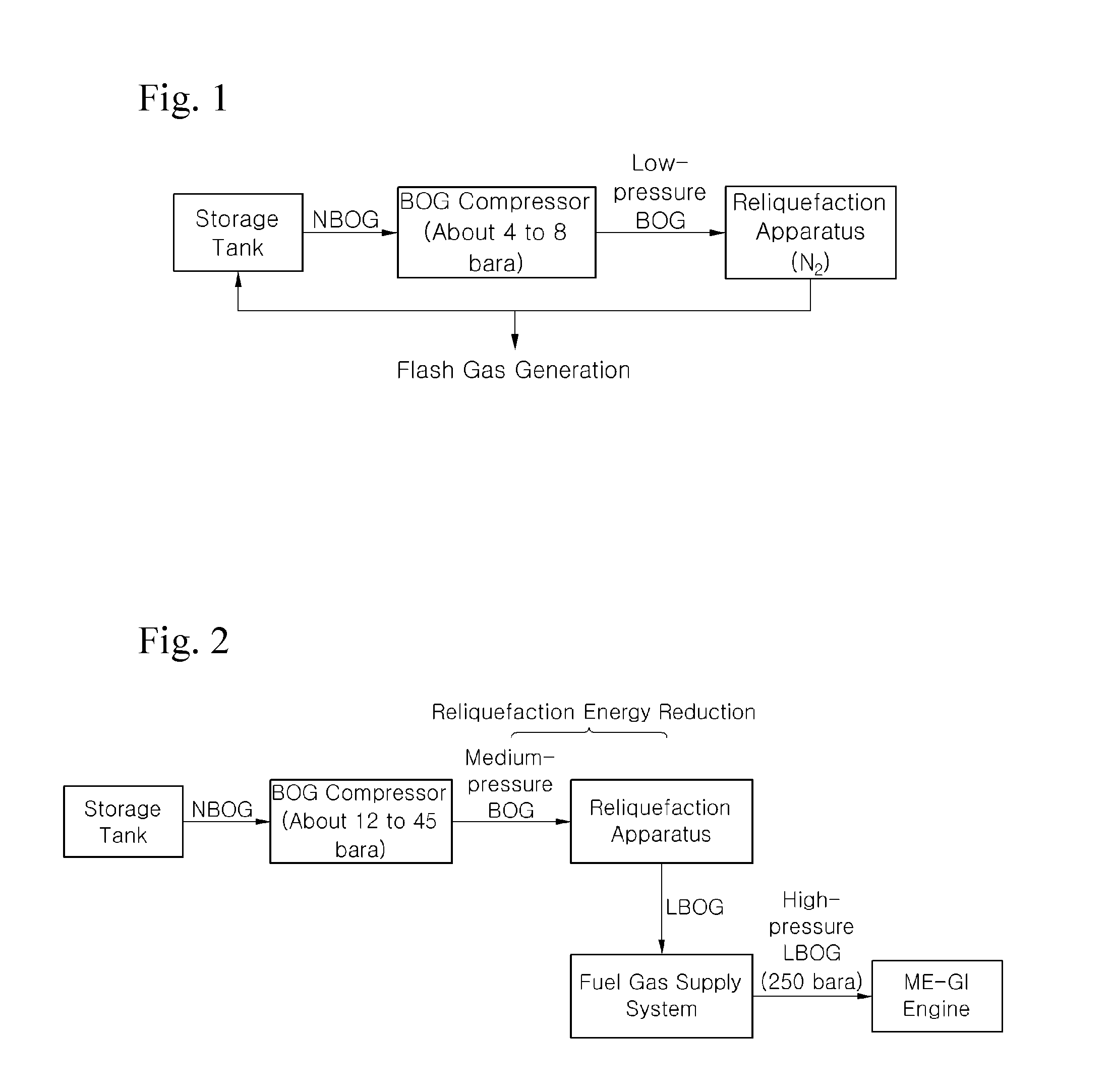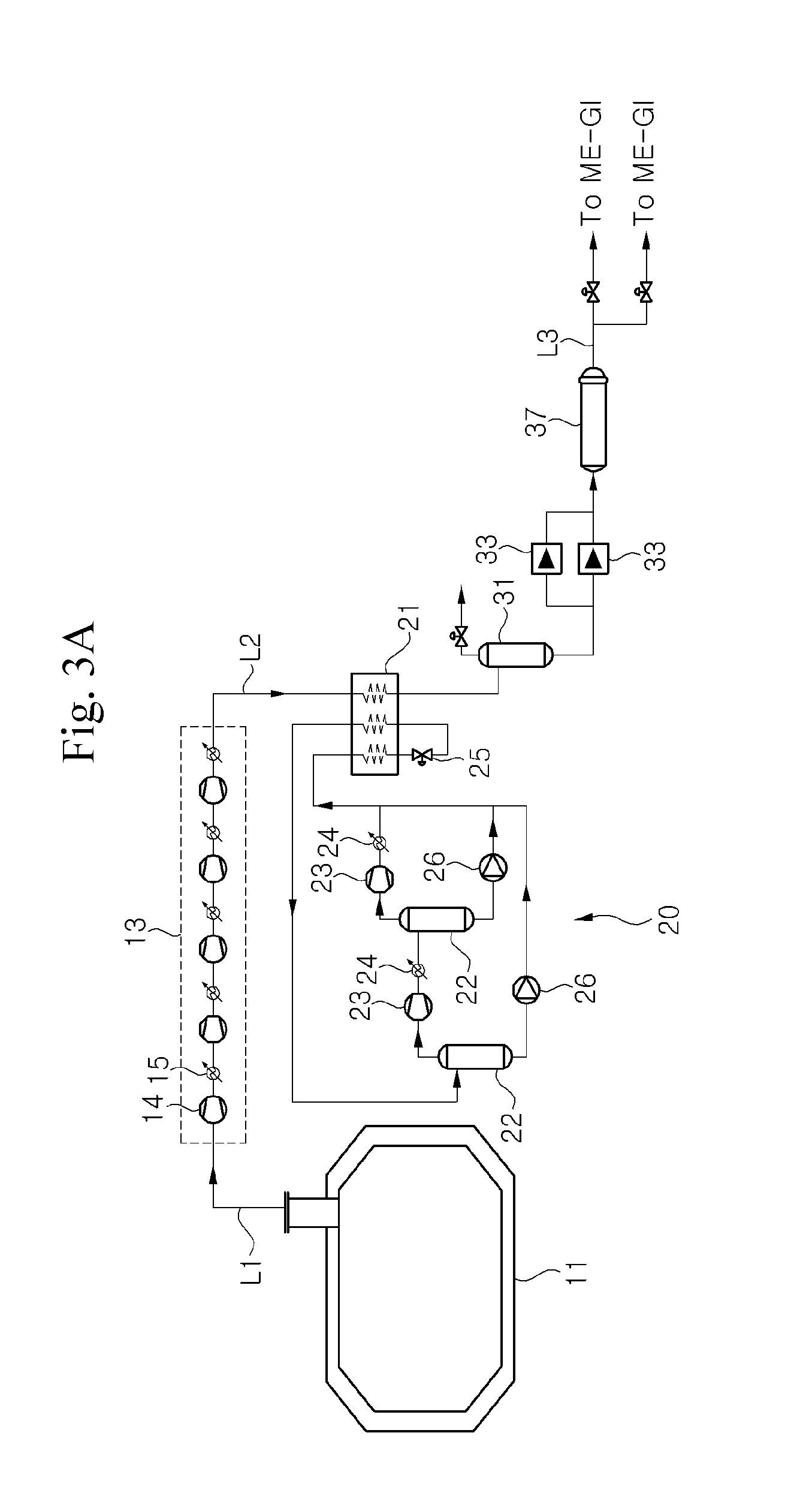System for supplying fuel to high-pressure natural gas injection engine having excess evaporation gas consumption means
a high-pressure natural gas and fuel supply technology, which is applied in the direction of machines/engines, liquefaction, lighting and heating apparatus, etc., can solve the problems of low liquefaction efficiency, low reliquefaction efficiency, flash gas generation, etc., and achieves a decrease in liquefaction energy, liquefaction energy consumption in reliquefaction, and the effect of increasing the liquefaction point of the bog
- Summary
- Abstract
- Description
- Claims
- Application Information
AI Technical Summary
Benefits of technology
Problems solved by technology
Method used
Image
Examples
first embodiment
Modified Example of First Embodiment
[0086]FIG. 3B illustrates a fuel supply system according to a modified example of the first embodiment of the present invention. Since the modified example of the first embodiment is partially different from the first embodiment in terms of the configurations of a BOG compression unit 13 and a liquefaction apparatus 20, only the difference therebetween will be described below.
[0087]The modified example of the first embodiment illustrated in FIG. 3B is substantially identical to the first embodiment illustrated in FIG. 3A in that the BOG compressing unit 13 includes five BOG compressors 14, but is different from the first embodiment in that an intermediate cooler 15 is not disposed between the first and second BOG compressors and between the second and third BOG compressors included in the BOG compression unit 13. According to the present invention, the intermediate cooler 15 may or may not be disposed between every two BOG compressors 14.
[0088]Als...
second embodiment
Modified Example of Second Embodiment
[0113]FIG. 7B is a configuration diagram illustrating a fuel supply system according to a modified example of the second embodiment of the present invention. As described in the modified example of the first embodiment, the modified example of the second embodiment is partially different from the second embodiment in terms of the configurations of a BOG compression unit 13 and a reliquefaction apparatus 20.
[0114]That is, the modified example of the second embodiment is substantially identical to the second embodiment in that the BOG compression unit 13 includes five BOG compressors 14, but is different from the second embodiment in that an intermediate cooler 15 is not disposed between the first and second BOG compressors and between the second and third BOG compressors included in the BOG compression unit 13. According to the present invention, the intermediate cooler 15 may or may not be disposed between every two BOG compressors 14.
[0115]Like ...
third embodiment
Modified Example of Third Embodiment
[0121]FIG. 8B is a configuration diagram illustrating a fuel supply system according to a modified example of the third embodiment of the present invention. The modified example of the third embodiment is partially different from the third embodiment in terms of the configuration of a reliquefaction apparatus 20.
[0122]That is, like the reliquefaction apparatus 20 according to the modified example of the first embodiment illustrated in FIG. 3B, the reliquefaction apparatus 20 according to the modified example of the third embodiment includes a cold box 21 configured to exchange heat between a refrigerant and BOG, a compression unit configured to compress the refrigerant that is heated and at least partially gasified by the cold box 21, an expansion unit configured to expand the compressed refrigerant to reduce the temperature thereof, and a gas-liquid refrigerant separator configured to separate the gaseous refrigerant and the liquid refrigerant.
[0...
PUM
 Login to View More
Login to View More Abstract
Description
Claims
Application Information
 Login to View More
Login to View More - R&D
- Intellectual Property
- Life Sciences
- Materials
- Tech Scout
- Unparalleled Data Quality
- Higher Quality Content
- 60% Fewer Hallucinations
Browse by: Latest US Patents, China's latest patents, Technical Efficacy Thesaurus, Application Domain, Technology Topic, Popular Technical Reports.
© 2025 PatSnap. All rights reserved.Legal|Privacy policy|Modern Slavery Act Transparency Statement|Sitemap|About US| Contact US: help@patsnap.com



